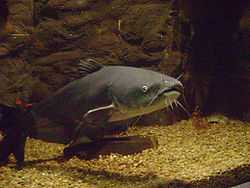Blue catfish
| Blue catfish | |
|---|---|
 | |
| Conservation status | |
| Not evaluated (IUCN 3.1) | |
| Scientific classification | |
| Kingdom: | Animalia |
| Phylum: | Chordata |
| Class: | Actinopterygii |
| Order: | Siluriformes |
| Family: | Ictaluridae |
| Genus: | Ictalurus |
| Species: | I. furcatus |
| Binomial name | |
| Ictalurus furcatus (Valenciennes, 1840)[1] | |
The blue catfish, Ictalurus furcatus, is the largest species of North American catfish, reaching a length of 165 cm (65 in) and a weight of 68 kg (150 lb). The average length is about 25-46 inches (64-117 cm). Blue catfish are distributed primarily in the Mississippi River drainage, including the Missouri, Ohio, Tennessee, and Arkansas Rivers.[2] These large catfish have also been introduced in a number of reservoirs and rivers, notably the Santee Cooper lakes of Lake Marion and Lake Moultrie in South Carolina, the James River in Virginia, Powerton Lake in Pekin, Illinois, and Springfield Lake in Springfield, Illinois. This fish is also found in some lakes in Florida.[3]
Record-setting fish
On June 18, 2011, Nick Anderson of Greenville, NC reeled in a 143-pound blue catfish. The fish was caught in John Kerr Reservoir, more commonly known as Buggs Island Lake, on the Virginia-North Carolina border. On June 22, 2011, the Virginia Dept of Game and Inland Fisheries certified the blue catfish as the state's largest, setting a new state record.[4] The fish had a length of 57 inches (145 cm) and a massive girth of 47 inches (120 cm).
On February 7, 2012, a 136-lb blue catfish was caught on a commercial fishing trot line in Lake Moultrie, one of the two Santee Cooper lakes, near Cross, South Carolina. It was 56 inches long. The fish is the largest blue catfish ever weighed on a certified scale in South Carolina, but it is not eligible for state record certification because it was not caught on a rod and reel.
On July 20, 2010, a yet to be certified new world record blue catfish was caught by Greg Bernal of Florissant, Missouri, on the Missouri River. Greg's girlfriend, Janet Momphard, a nurse from St. Charles, helped land the world-record fish. The record catfish weighed in at 130 lbs. It was 57 inches long and 45 inches in girth. The previous angling world record, 124 lb, was caught by Tim Pruitt on May 22, 2005, in the Mississippi River.[5][6] This record broke the previous blue catfish record of 121.5 Lbs caught from Lake Texoma, Texas.
The Indiana Record for a blue catfish was set in 1999 by Bruce Midkiff. The fish was caught in the Ohio River and weighed in at 104 pounds.[7]
Diet
Blue catfish are opportunistic predators and will eat any species of fish they can catch, along with crawfish, freshwater mussels, frogs, and other readily available aquatic food sources; some blue catfish have reportedly attacked scuba divers in the Mississippi River. Catching their prey becomes all the more easy if it is already wounded or dead, and blue cats are noted for feeding beneath marauding schools of striped bass in open water in reservoirs or feeding on wounded baitfish that have been washed through dam spillways or power generation turbines.
Due to their opportunistic nature, blue catfish will usually take advantage of readily accessible food in a variety of situations, which from the angler's perspective makes cut-up or dead baits, and even stink baits an excellent choice to target these fish. Blue cats will also respond well to live baits, with live river herring and shad usually a top choice, followed by large shiner minnows, sunfish, suckers, mullet], dead shrimp and carp. All of the above baits can be used as fresh cut baits with good success and freshwater drum also work well. Generally, a fairly large piece of cut bait (4-12 inches long) on a fairly large hook (3/0 to 9/0) is a good choice in rivers or reservoirs where large blue cats (50 lb and up) are a possibility. Depending on currents, sinkers ranging from 1/2 to 8 oz may be required, with 1-2 oz a good choice for many situations. To catch large blue catfish in rivers, the more current, the better usually, although fishing along current edges and breaks is often a good option. Blue catfish tend to favor deeper water in larger rivers and reservoirs, but will make feeding and spawning forays into relatively shallow water. Blue catfish can be frequently caught in warmer climates in water as shallow as 12 in. For the largest of specimens, fishing for them requires incredibly strong tackle; often fishermen targeting them will choose saltwater tackle such as a large, heavy-action pole with 100-lb-test line, and 10/0 circle hooks, with a 2-lb chunk of cut skipjack herring. Blue catfish are incredible fighters, and are often considered game fish due to their reputation for attacking anything from panfish baits to artificial bass lures.
See also
- Flathead catfish (Pylodictis olivaris), another very large North American catfish
References
- ↑ "Ictalurus furcatus". Integrated Taxonomic Information System. Retrieved 11 March 2006.
- ↑ Froese, Rainer and Pauly, Daniel, eds. (2011). "Ictalurus furcatus" in FishBase. December 2011 version.
- ↑ Hook and Bullet website, at http://www.hookandbullet.com/fishing-lake-placid-placid-lakes-fl/ .
- ↑ http://www.dgif.virginia.gov/news/release.asp?id=301
- ↑ Blue catfish receives world record status from the IGFA Retrieved 5 September 2006
- ↑ IDNR Announces World's Largest Blue Catfish Caught Retrieved 5 September 2006 Archived April 27, 2006 at the Wayback Machine
- ↑ http://www.eregulations.com/indiana/fishing/record-fish-program/
- Salmon, M. H. III (1997). The Catfish As A Metaphor. Silver City, New Mexico: High-Lonesome Books. ISBN 0-944383-43-2.